Article and all photos by Joe Mock, BaseballParks.com
All rights reserved
 |
If you don’t live in Tulsa, then you might not know how to pronounce the name of the city’s beautiful new ballpark, ONEOK Field. You might be inclined to call it “on-ee-oak.” Or “one-O.K.” Or maybe you think the “OK” part is short for Oklahoma, meaning you’d pronounce it “one-Oklahoma.” Or you might even guess that you’re supposed to sound out each letter, as if it’s a set of initials: “oh-en-ee-oh-kay.”
| Ballpark Stats |
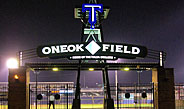 |
| Team: The Tulsa Drillers of the Double-A Texas League |
| First game: April 8, 2010 — a 7-0 loss to Corpus Christi |
| Capacity: 7,833, of which 6,333 are fixed seats |
| Architect: Populous (formerly called HOK) |
| Construction: Manhattan |
| Price: $39.2 million for construction; total project was $60 million |
| Home dugout: First base side |
| Field points: South by southeast |
| Playing surface: TifSport Bermuda grass |
| Betcha didn’t know: ONEOK Field isn’t Tulsa’s first downtown ballpark. Prior to 1932, the city’s team played at six different parks, all of which were downtown. |
All of those guesses are wrong. The correct pronunciation is “one oak,” because the company that acquired the naming rights pronounces its own name that way. That energy company, indeed named ONEOK, has been headquartered in downtown Tulsa for over seven decades and today employs about 1,300 area residents.
But if you have a difficult time getting used to the name of the park, here’s something that might be tougher: when was the last time you associated zinc with a baseball facility?
Ahh, more on that in a moment. First, let’s take a look at how this unique facility came to be.
While the Tulsa Drillers had the largest park in the Texas League, Drillers Stadium was nowhere near the nicest. Sure, they could pack in over 10,000 fans (especially when Oklahoma State hosted the Oklahoma Sooners in baseball each year), but the place was neither comfortable nor fan-friendly. Chuck Lamson, president of the team, knew that other Double-A franchises were grabbing fantastic new parks, and understandably, he wanted that for his fans, too.
He worked long and hard with the city of Tulsa on a new venue, but it seemed to me that Tulsa’s heart wasn’t in it. In 2007, though, a developer approached the Drillers with the idea for a new ballpark to anchor a large entertainment project that he wanted to build on the banks of the Arkansas River in the suburb of Jenks, just south of Tulsa. Lamson signed an agreement to negotiate only with that developer … and, you guessed it, that quickly captured the attention of the city of Tulsa.
Kathy Taylor, Tulsa’s mayor at the time, pulled together city leaders to determine if it was worth it to expend the effort and capital to keep the Drillers in the city limits. The answer was a resounding “yes,” and within a few months, Lamson broke off talks with the folks in Jenks (by the way, as of this writing, that development hasn’t materialized) and serious discussions ensued with Tulsa officials early in 2008.
After rejecting two other possible sites, talks started to center on a small parcel of land in the northeast corner of downtown that was owned by the Tulsa Development Authority. Anxious to spur development in a historic portion of downtown that desperately needed it, a deal was quickly finalized to construct a park there.
Like most cities, Tulsa didn’t have a lot of extra money, so an unusual arrangement was devised to pay for the $60 million project. $30 million would come from private donations (that were solicited based on the premise that the the park would spur economic development downtown), $5 million from the Drillers’ lease and the remainder from a very controversial assessment fee imposed on downtown property owners. Those business owners were none too pleased with these new fees, which the city insisted wasn’t a tax. Helping to ease the situation during the tough economic times of recent years, a $25 million revenue bond was acquired from the Tulsa Stadium Trust, which was set up to own and operate the ballpark, by the Tulsa Community Foundation. This bond will be repaid as downtown businesses pay the annual assessments over time.
| Left behind |
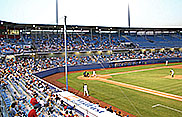 |
| Drillers Stadium was the team’s home from 1981 through 2009. Built at a cost of $3 million, it had the largest seating capacity in the league, but none of the modern-day comforts fans expect. It had only one entryway, no walk-in store and only four luxury suites. It’s located next to the race track at the city’s fairgrounds. |
Manhattan Construction Company was given the responsibility of designing and constructing the facility in what is known as a “design-build” arrangement. They brought on nationally known architects Populous (formerly known as HOK), and a ground-breaking ceremony was held on the site on December 19, 2008. “When construction started, we had no actual construction documents, so we built and Populous designed at the same time — which takes an enormous effort and considerable coordination,” Bob Jack, Project Executive at Manhattan, told me. When you’re starting from scratch, “the process normally takes 22 to 24 months. This project was designed, built and turned over to the Drillers in 14 months.” This was certainly quite an accomplishment, and the team played its first game in its new home on April 8, 2010.
You should also consider the wealth of ballparks in the eight-team Texas League. Now that the Drillers have a new home, that means that the oldest park in the TL is the still-modern-looking Wolff Municipal Stadium in San Antonio, and it’s only in its 17th season. The other seven have opened since 2002, which is remarkable. Tom Kayser, long-time president of the TL, presides over the best crop of ballparks in any league in the Minors.
Those new parks brought with them a certain measure of instability, in that Frisco, Corpus Christi, Springfield and Northwest Arkansas all built new ballparks to lure franchises from other locales. The Arkansas Travelers, meanwhile, remained in the same metro area, but changed cities from Little Rock to North Little Rock, the latter being the smaller but much more progressive municipality that was able to get the new facility built while Little Rock was unable to make it happen after years of trying. The moving vans for the Tulsa Drillers, thankfully, had to travel less than five miles to move from old Drillers Stadium to ONEOK Field.
And all of these great facilities have done incredible things for the eight teams’ attendance figures. Consider the Midland RockHounds, who moved into the stadium now called Citibank Park in 2002. In 2009, they drew a whopping 282,283 fans, their second-highest total ever — and that still left them in last place in attendance in the eight-team league!
The Setting
Let’s start our analysis of ONEOK Field with its surroundings. Was its location a wise choice by the city and team?
As I visited the construction site several times prior to the park’s opening, I drew the conclusion that it was not a wise selection. It was in a part of downtown that was blocks away from any newly constructed buildings, and what structures there were around it were anything but impressive. Not only that, an Interstate highway seemed to be far too close to the backside of the main structure.
But when I visited the completed project shortly after opening day, and I studied the history of the park’s neighborhood, I changed my mind.
The neighborhood adjacent to the park is known as Greenwood. This area has a storied past, but until the ballpark came along, the buildings that make up this business district weren’t looking too nice.
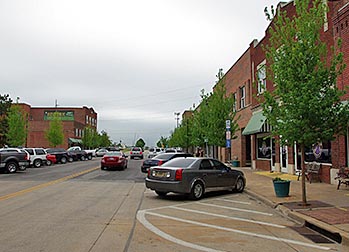  |
Today, thanks to the attention directed at Greenwood because of the ballpark, the brick exteriors have been sandblasted and look as good as ever. There’s even a special entry to the ballpark that you access by walking through one of these buildings (above right). Adjacent to this walkway is Fat Guy’s, a burger joint that is quite popular before and after games. Also along Greenwood Avenue you’ll find a clothing store, a hat shop, convenience store and more.
If you continue north along Greenwood Avenue, you’ll pass under an overpass for Interstate 244. What lies on the other side is Oklahoma State University – Tulsa, the entryway of which is the home of the Greenwood Cultural Center with its interesting architecture. More important than that is the fact that this is where the history of the area is preserved. Take a few minutes to read the historical accounts on their website. I was completely unaware of the very significant events which took place here. In a nutshell, Greenwood was known as “America’s Black Wall Street” in the early 1900s, as the neighborhood was a pivotal financial center for African-American businesses both near and far. However, “race riots” erupted here on June 1, 1921, and 35 city blocks of black-owned businesses and homes were destroyed.
Don’t make the assumption that the blacks who lived here felt they were victims of injustice and rioted to demonstrate their anger. No, whites from other parts of Tulsa looted, murdered and torched their way across those 35 blocks. There were 39 confirmed deaths (their names are carved on The Black Wall Street Memorial within the Cultural Center’s grounds), but the actual death toll probably exceeded 300, making it the deadliest race riot in U.S. history. To make matters worse, when the carnage was over in 1921, insurance companies refused to pay the property claims of the owners of those destroyed buildings, and the city passed an ordnance that greatly hindered the rebuilding of the area. To say this is a shameful chapter in American history is an understatement, and once I became aware of this neighborhood’s past, I became a convert: yes, this is exactly where the ballpark should’ve been constructed.
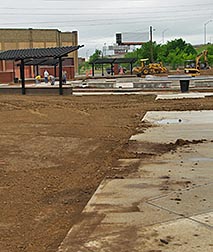 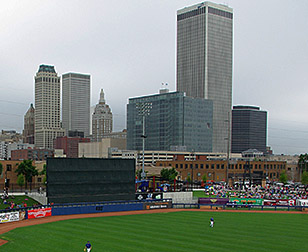 |
On the other side of the ballpark from Greenwood Avenue is John Hope Franklin Reconciliation Park, a city park that was built to remember the riot of 1921. The city is putting a lot of work into new seating areas and facilities at this park (above left), and it should be a showplace very soon.
As you move toward the tall buildings of downtown, you enter two other neighborhoods, both known for their dining and entertainment venues. This is where you’ll find Tulsa’s nightlife, particularly on the weekends. Just three blocks south of ONEOK Field is the Blue Dome District, which features half a dozen restaurants and several music venues, including the famous Jazz Depot. Three blocks due west of the ballpark is Brady Village where you’ll find more eateries and clubs, as well as the historic Cain’s Ballroom and Brady Theater.
These two entertainment areas were a pleasant discovery for me. As many times as I had visited Tulsa over the years, I had no idea they were there. No doubt, the owners of these businesses are glad that the ballpark is attracting thousands of visitors to downtown Tulsa!
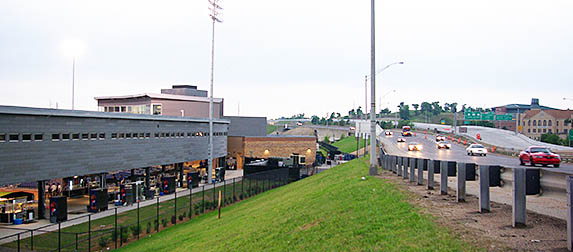 |
Again, I was concerned about the proximity of Interstate 244 on the north side of the ballpark (above). I feared that it would be noisy and negatively impact the way that side of the ballpark’s exterior would look. I needn’t have worried. The architects took it all in stride … but it didn’t start out that way.
“When we first examined the site, we saw two big challenges,” I was told by Steve Boyd, the Lead Project Designer at Populous, the architects for ONEOK Field. “One was its size, because eight and a half acres isn’t very large. The other was its geometry, because the shape limited the ways we could place the park (on the site). We did some modeling of different ways to orient the park to make sure the sun wasn’t going to be in the players’ eyes, and in the end we rotated the (seating) bowl to fit the shape of the site. Because of the view the fans have of the downtown buildings, the result was really outstanding.” Indeed, when all was said and done, the extra distance from the park to the tall buildings turned out to be a blessing, because it permits a great view of the skyline. Boyd admitted that this was his favorite aspect of the ballpark. “When you’re sitting in a seat, you have a fantastic view of the city. It’s really inspiring to me.”
Like the new parks that opened in Ft. Wayne and Bowling Green in 2009, ONEOK Field is downtown but not right downtown. These three parks are on the edge of their cities’ main commercial districts where development was needed and where new and old businesses have some room to flourish. Tulsa’s park probably has the best view of the three, by the way.
So I wasn’t a fan of this location as the park was being constructed, but once I saw the view from the seats, saw the entertainment districts nearby and, most importantly, learned the history of the neighborhood, I became a believer. This is indeed an excellent site.
The Exterior
Normally, the showiest side of a park’s exterior is behind the infield. This is usually where the main entryway is located, and a lot of effort is expended by architects to make this side of the facility attractive. Well, as mentioned above, with the Interstate so close to this side of ONEOK Field, not a lot of fans are going to enter on this side of the ballpark. That didn’t stop Populous from making this side appealing (below), and this turns out to be a good thing, because traffic on the Interstate gets a close-up view of the park here — and I noticed after leaving the park following the night game I attended that the lighting on this side of the exterior is gorgeous, giving passersby a beautiful scene.
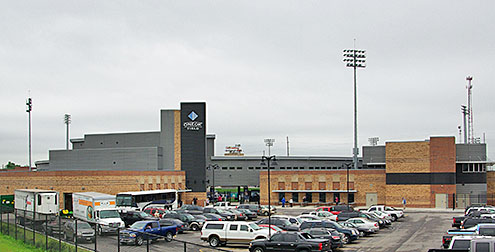 |
In this respect, ONEOK Field reminds me of BASEBALLPARKS.COM’s Ballpark of the Year for 2009, Huntington Park in Columbus. Here, there is lovely brickwork all around the home-plate entry, but most fans will never see it because they enter the facility through the outfield gates, where the parking lots and ticket booths are located.
In the brickwork near Tulsa’s home-plate entry is a set of pretty “medallions.” These concrete panels (below left) pay homage to such things as the Greenwood neighborhood, the city itself and the importance of oil to the area. These are done in an art deco style, which is particularly appropriate since many downtown buildings (built in the 1920s during the oil boom) in Tulsa are known for their art deco architecture.
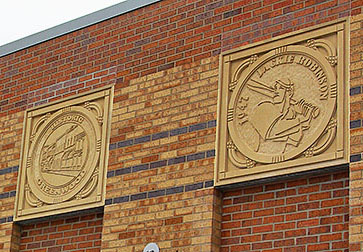 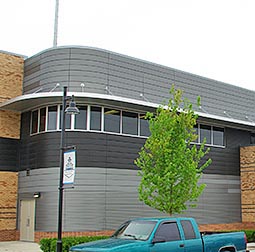 |
The aspect of ONEOK Field’s exterior that intrigues me the most, though, is the color scheme that lies beyond the light-colored brickwork behind home plate. As you walk around the building, you see a beautifully understated array of neutral colors, particularly shades of gray (above right). Another beautiful ballpark in the Texas League, Whataburger Field in Corpus Christi, also has hues like this on its exterior, but Tulsa’s new facility incorporates more brick, and in Corpus Christi, there is an unusual use of wood.
The building material most responsible for creating this distinctive look is, believe it or not, zinc. In fact, there’s 35,000 square feet of zinc covering the outside of this ballpark! “Tulsa’s ballpark is the first to use zinc,” Boyd said proudly. “One of the key concepts driving the design of the park was the area in which it’s located. Since the oil industry is so important there, we thought of the strata of the terrain. The different hues of the zinc represent the layers of rock and oil (below the ground). And when you look at zinc from different angles, it changes its appearance. In fact, we decided to rotate some of the panels so the grain was running in the opposite direction. It gave those panels a completely different look.”
I really like both the look and the thinking behind this — plus “Zinc is a very natural material,” Boyd added. “That helped us make the ballpark ‘green’ and that’s important to us.” He also praised zinc’s durability. “It will outlive the building,” he joked, adding that “zinc has an 80- or 100-year life.”
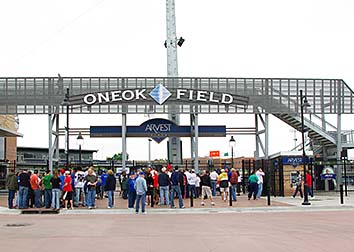  |
There are five entryways into ONEOK Field. The two most noteworthy ones are near the ticket windows behind first base (above left — there’s even a walkway to one of the party decks across the top of it) and in right field (above right). The latter features a 30-foot-tall oil derrick, making it both the perfect meeting place before games and an appropriate symbol for a team called the Drillers.
And, as has become a trend in new Minor League parks these days, the fencing around the outfield perimeter allows those on the outside to peer in at the goings-on. This is part of the objective of making the park inviting and accessible — and it works.